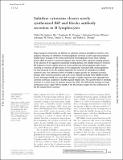Subtilase cytotoxin cleaves newly synthesized BiP and blocks antibody secretion in B lymphocytes
Author(s)
Hu, Chih-Chi Andrew; Dougan, Stephanie K.; Winter, Sebastian Virreira; Paton, Adrienne W.; Paton, James C.
DownloadHu-2009-Subtilase cytotoxin.pdf (4.399Mb)
PUBLISHER_POLICY
Publisher Policy
Article is made available in accordance with the publisher's policy and may be subject to US copyright law. Please refer to the publisher's site for terms of use.
Terms of use
Metadata
Show full item recordAbstract
Shiga-toxigenic Escherichia coli (STEC) use subtilase cytotoxin (SubAB) to interfere with adaptive immunity. Its inhibition of immunoglobulin secretion is both rapid and profound. SubAB favors cleavage of the newly synthesized immunoglobulin heavy chain–binding protein (BiP) to yield a C-terminal fragment that contains BiP’s substrate-binding domain. In the absence of its regulatory nucleotide-binding domain, the SubAB-cleaved C-terminal BiP fragment remains tightly bound to newly synthesized immunoglobulin light chains, resulting in retention of light chains in the endoplasmic reticulum (ER). Immunoglobulins are thus detained in the ER, making impossible the secretion of antibodies by SubAB-treated B cells. The inhibitory effect of SubAB is highly specific for antibody secretion, because other secretory proteins such as IL-6 are released normally from SubAB-treated B cells. Although SubAB also causes BiP cleavage in HepG2 hepatoma cells, (glyco)protein secretion continues unabated in SubAB-exposed HepG2 cells. This specific block in antibody secretion is a novel means of immune evasion for STEC. The differential cleavage of newly synthesized versus "aged" BiP by SubAB in the ER provides insight into the architecture of the ER compartments involved.
Date issued
2009-10Department
Massachusetts Institute of Technology. Department of Biology; Whitehead Institute for Biomedical ResearchJournal
Journal of Experimental Medicine
Publisher
Rockefeller University Press
Citation
Chih-Chi, Andrew Hu, et al. (2009). Subtilase cytotoxin cleaves newly sythesized BiP and blocks antibody secretion in B lymphocytes. Journal of experimental medicine 206: 2429-2440. © 2009 Rockefeller University Press
Version: Final published version
ISSN
1540-9538
0022-1007
Keywords
animals, antibodies, immunology, B-lymphocytes, drug effects, B-lymphocytes, immunology, cell membrane, drug effects, endoplasmic reticulum, drug effects, endoplasmic reticulum, metabolism, escherichia coli proteins, pharmacology, heat-shock proteins, biosynthesis, heat-shock proteins, chemistry, histocompatibility antigens class I, immunology, immunoglobulin M, immunology, immunoglobulin kappa-chains, immunology, interleukin-6, secretion, intracellular space, drug effects, intracellular space, metabolism, mice, models, immunological, peptide fragments, metabolism, protein folding, drug effects, protein transport, drug effects, subtilisins, pharmacology, antibodies, escherichia coli proteins, heat-shock proteins, histocompatibility antigens class I, immunoglobulin M, immunoglobulin kappa-chains, interleukin-6, peptide fragments, molecular chaperone grp78, subtilase cytotoxin, e coli